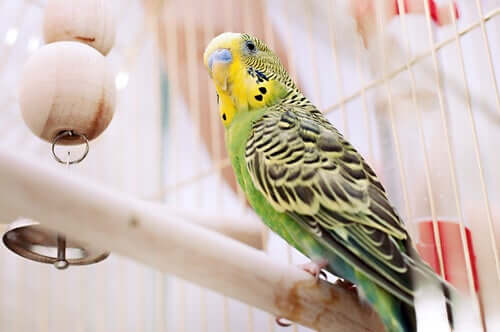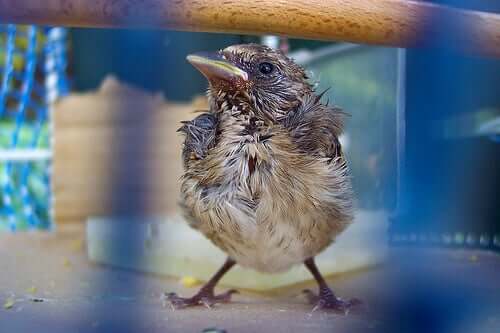5 Illnesses in Caged Birds

What illnesses do caged birds suffer from?
Do you have pet birds in your home? Then you need to know about certain illnesses that they can suffer as a result of living in cages. Some problems are the result of climatic factors and others have to do with a lack of proper care. And finally, others appear simply because a bird is unhappy.
1. Pseudo molt
Birds are often taken to places that are far away from their natural habitat. As a result, they must get used to changes in climate. However, their bodies continue to “think” as if they were still in their original ecosystem and they act accordingly.
This occurs when the region is too warm for the bird, or when their owners have the heating up too high in their home. As a result, animals shed their feathers more often than normal. Why? In order to keep their body temperature from going up.

You may be asking why this is a problem. The fact is, this changing of feathers takes up a lot of energy. It alters their natural cycle and can even lead to death. To keep this from happening, be sure to keep your bird in a cool place where there’s sunlight, but also hours of shade.
2. Ornithosis
Also known as psittacosis, this is a highly contagious infectious disease that affects birds. A bacteria, chlamydia psittaci is the cause behind this disease. Any bird can carry the infectious agent in its feathers, tissues, and secretions.
Ornithosis is more frequent in turkeys, ducks, and pigeons. It also affects canaries, although it’s not fatal in this case. This disease can also spread to human beings and domestic mammals. The symptoms of this illness in birds are the following:
- Swollen belly
- Lack of appetite
- Greenish excrement
- Respiratory problems
3. Stress
This is another typical illness that affects caged birds… especially in those that weren’t born into captivity. The fact that they go from being free to living in a small cage is no doubt traumatic for the animals. What’s more, they often find themselves living in cages with several other birds.
One of the ways in which we can discover if a bird is suffering from stress is by analyzing their behavior. They may scratch themselves, peck at themselves, and hurt themselves in order to reduce their anxiety.
4. Follicle cysts
These cysts are protuberances that appear on any part of the animal’s body, although they’re more common below the wings. It requires the intervention of a veterinarian who must remove them surgically.
Cysts appear when feathers, for some reason, grow inwards instead of outwards. They’re a common issue in birds with dense plumage like parrots and canaries.
5. Parasites
While this isn’t a very common problem in caged birds, it’s still something we need to look out for. When a new bird arrives at your home, it may have internal or external parasites. What’s more, it may spread these parasites to other birds in its cage.

In the case of external parasites, these live on the skin and among the feathers. At the same time, internal parasites can dwell in a bird’s intestines, blood, or below the dermis. The symptoms of the former can include a number of symptoms. For example, anorexia, lethargy, diarrhea, abdominal swelling, weight loss, the presence of worms in fecal matter, weakness in the wings, and other symptoms.
In order to determine if your bird has parasites, you need to take a stool sample to the vet. Another option is for a professional to extract blood and analyze it. Once your veterinarian determines the prognosis, he or she will indicate the right course of treatment.
All cited sources were thoroughly reviewed by our team to ensure their quality, reliability, currency, and validity. The bibliography of this article was considered reliable and of academic or scientific accuracy.
- Juaréz, M. (2014) LA IMPORTANCIA DE LA ENTERITIS NECRÓTICA EN LA SALUD DE LAS AVES ACTUALES. Sitio Argentino de Producción Animal. Recuperado el 12 de marzo de 2022, disponible en: https://www.produccion-animal.com.ar/produccion_aves/enfermedades_aves/48-Enteritis_Necrotica.pdf
- Piñeiro, C. J. S., & Bert, E. (2011). Medicina de urgencia en aves ornamentales. REDVET. Revista Electrónica de Veterinaria, 12(7), 1-29.
- Nett‐Mettler, C. S. (2013). Allergies in Birds. Veterinary Allergy, 422-427.